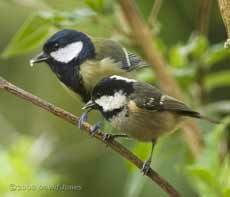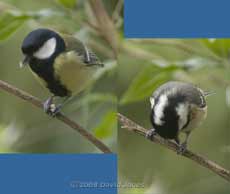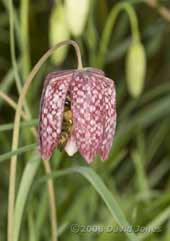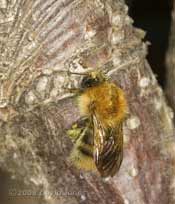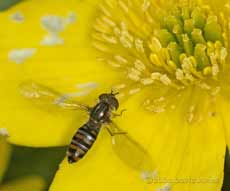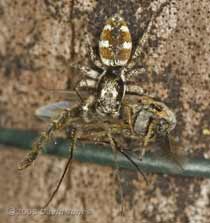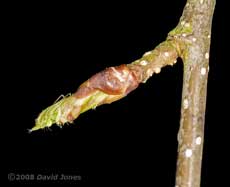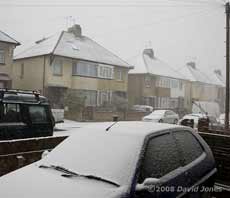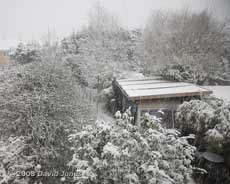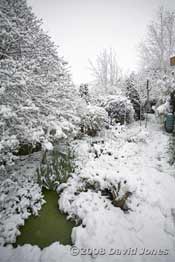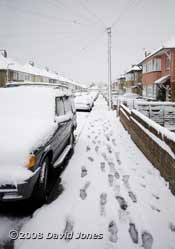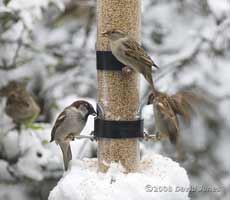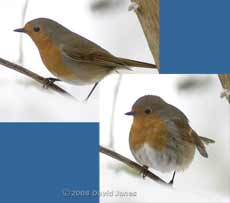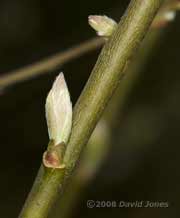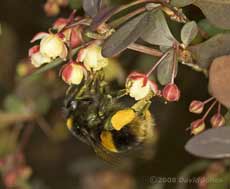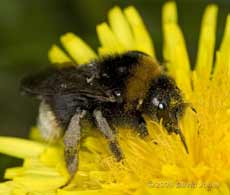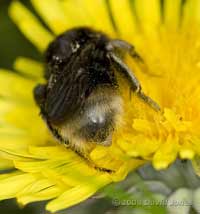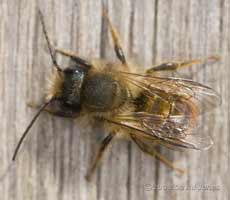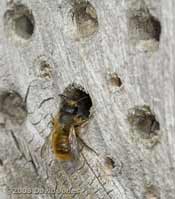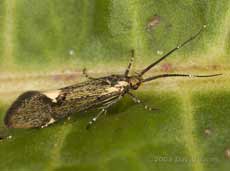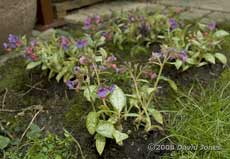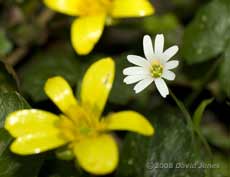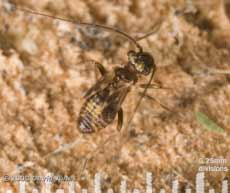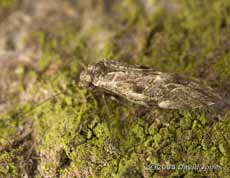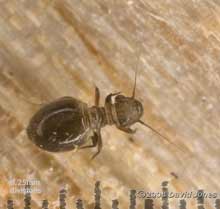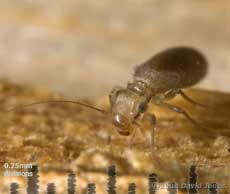Go to the last entry on this page .....Go to previous entry2 April - After a bright, and largely sunny start to the month yesterday, it seems that April was only fooling us - today it is grey and damp, with the forecast suggesting colder weather during the weekend. One bit of brightness this morning came in the form of male Blackcap visiting the Ivy tree. It's only the second one I've see through the winter, the previous sighting being on 12 January.
Well, not really! The Great Tit is 'our' male, and the Coal Tit is one of a pair that I have seen coming for food several times over the last two days. Conveniently, they both perched on almost the same spot on the same branch (but separately) to eat bits from the bird table, and I decided to blend two pictures together to get a comparison of the sizes and colourings of the two species.
It was interesting to compare the different stance each took as they ate the peanut (Great Tit) or Sunflower kernel (Coal Tit). The Great Tit's use of both feet to hold the nut makes it look quite unstable.
4 April - With the forecasters talking of snow during the coming weekend, today was more like summer with sunshine and the temperature over 16C. Despite the sunshine I'm afraid that I spent much of the day indoors fiddling with my cctv arrangements and doing other things, but I did manage to escape into the garden for a short time. Understandably, there were more flying insects to be seen today, but it was very difficult to get close. For example there was at least one Tawny Mining Bee (Andrena fulva) flying about and making approaches to the bee hotels, but getting a photograph was impossible.
However I did mange to get closer to a bumble bee after I spotted it visiting one of the Snakes-head Fritillary flowers. The flower itself provides a great degree of privacy for bee visitors, so I had to wait for it to emerge.
I missed its departure, but the the bumblebee headed for a log where it seemed to be brushing off a great deal of the pollen that had stuck to it. I'm not completely certain about its identification, but it is probably the Common Carder Bee (Bombus pascuorum). I was surprised I didn't see or hear more bumblebees about today, although a very large Buff-tailed Bumble bee did find its way into our kitchen.
The sunshine also brought out small numbers of hoverflies, including this hoverfly (probably Episyrphus balteatus) that was about to land on the anthers of a Marsh Marigold.
The influx of insects means that the spiders had a chance to grab a meal if an insect should land in the wrong place to 'sunbathe'. Here, a small A Zebra Spider (Salticus scenicus) has caught what looks like a midge of some sort.
Also, I saw my first Ladybirds of the year, sadly they were Harlequin Ladybirds, and both were out of reach of the camera.
5 April - As the weather goes downhill, after quite a bit of rain last night today was largely cloudy with some dampness, and a stiff Northerly breeze made it feel quite a bit colder than the maximum of around 10C.
Just one picture from the garden today, to record the bursting of the buds on our Himalayan Birch tree, at least a week after my neighbour's Silver Birch.
6 April - Winter returns, at least for a few hours! I was up early this morning to watch what happened in the Great Tit box (nothing, as it happened!) and as dawn broke there was no sign of the snow that we had been promised.
Then, shortly before 7.30am it arrived.
For a short time it was just fine snow, but then it got heavier, and with it slightly wet it was able to cling to every surface, piling up on branches and making plants like the bamboo bow right down.
It kept going for an hour or so, and by the time it eased off enough for me to go outside with the camera the garden had become a real Christmas card scene.
However, the temperature never dipped to freezing, and walking on the snow quickly showed up its 'slushy' nature.
It seemed that many of the birds must have been sheltering during the worst of the snow, but as it eased up they started to appear. Amongst the Sparrows there seemed a general reluctance to perch on the branches of the Hawthorn until another bird had cleared the snow first, and for a while that problem even extended to the perches on the feeders.
I wasn't able to get that iconic shot of the Robin in the snow, but I was able to photograph both male (top) and female as they took turns to perch briefly on the same branch that I had photographed the Great and Coal Tits on a few days ago. As usual, the male looks well groomed while his female looks as though she has been busy in their nest, wherever that is.
Typical of any snowfall that we get at this time of year, by the early afternoon it has virtually all gone, and the sun is shining again. Looking back through my diaries, the last time I noted snow in April was on the 10th in 2003, although that didn't even warrant a picture.
11 April - After the snow we had several frosty mornings, followed by generally dry days. This morning were were frost-free, with the temperature dipping to around 3C before the rest of the morning was bright and sunny. However, in the early afternoon dark clouds rolled in and we had several heavy showers, with hail and thunder before it cleared up again for what remained of the day. A couple of things to record from the garden - first of all, yesterday I saw a Sparrowhawk for the first time this year. It was a female that was perched atop our Hawthorn, with numerous chattering Sparrows in the branches below her. She left without trying to catch any of them.
The last tree to start producing leaves is the Willow on the far side of the big pond. Took this picture yesterday, although I suspect a couple of the buds may have burst on the 9th.
A couple of weeks ago I mentioned that a Buff-tailed Bumblebee was scouting out the bottom of our compost container as a possible nest site. I can confirm that she is definitely in residence, although instead of getting in under the bottom rim of the container she is going in and out of the flap at the side of it - luck I don't intend to take out any compost in the foreseeable future! I hope that my putting more things on top will not upset the developing nest.
The Berberis is now in flower and when the sun shines it is a popular source of pollen for bumblebees. Here, a Buff-tailed queen continues to gather pollen to add to the load she has already collected.
Yesterday I photographed this individual on a Dandelion next to the pond. Comparing my photographs with the descriptions in by Bumblebee guide, I think it is a Southern Cuckoo Bumblebee (Bombus vestalis). While I haven't recorded one of these here before, it is the most common Cuckoo Bumblebee in this part of the UK.
Notice that it doesn't have a yellow band at the front end of the abdomen, and there is a broken yellow band just in front of a narrow white band. The tip of the abdomen is mainly black with some white at the sides. As the name suggests, the queens seek out the queen of another species to act as host, and in this case the host species is the Buff-tailed Bumblebee, so I shall be watching the comings and goings at the composter with some interest.
A week ago I mentioned seeing what I think is a Tawny Mining Bee (Andrena fulva). It's taken until today for me to get close enough to photograph one (and it's still just one that I'm seeing),
and here inspecting the accommodation at one of the bee hotels. To give an idea of scale, it is looking into a hole that has a diameter of 7mm.
15 April - Today has been an almost perfect Spring day, with only the occasional small cloud moving across the sun - pleasant enough for us to have our morning coffee break outside for the first time this year! And I saw my first butterfly of the year - an Orange-tip (Anthocharis cardamines) which flew across the garden without stopping here. I had dirty hands at the time (see below) so there was no chance of a photograph even if it had landed.
The nearest that I got later in the day was this micromoth which I will try to identify at some point.
I've put the plants at the top of the slope up to the West Wing , in the almost permanently shaded area to the left of the path just beyond the Ivy tree. It seems that the plant flowers best when in shade, and the bumblebees have already given them their vote of approval.
Last May I planted a Greater Stitchwort on the far side of the big pond, and today, I spotted this flower peeping out from amongst the Lesser Celandines. It's not quite where I planted the Stitchwort, but I'm very happy to see that the original plant didn't just disappear. I hope that more appear over the next couple of years.
In response to an e-mail from Bob Saville of the National Barkfly recording Scheme, I've been checking the logs that were the source of numerous barkfly photographs last year, and through the winter. There was very little to be seen on them this time, and I found just four altogether - three species including one new species for the garden.
First, I found a couple of examples of Epicaecilius pilipennis, a species known to occur all year round.
The second is a Loensia variagata . In
Bob's words, ' It's Whenever I examine the logs this is inevitably the first barkfly that I spot.
This third barkfly is one that hadn't photographed here previously. At first I thought it was a nymph, but Bob tells me that it is likely to be an adult (that has lost its wings) of a Lepinotus species.
He asked me to take a side view photograph of it so that he could see the side of its head. That was quite a challenge with the little creature, barely 2mm long constantly running about the log. Anyway, this was the nearest I got to a side view, and it shows a dark band between the eye and the base of the antenna which suggests that it is Lepinotus patruelis - later confrimed by Bob. Also, from this angle it appears to have very small wings. It seems that this is a species that is regarded as a common domestic species, but rarely found out of doors. I can be sure that this one didn't come from inside our house as the timber had only been stored outside.
Click on images to see larger versions |
|
